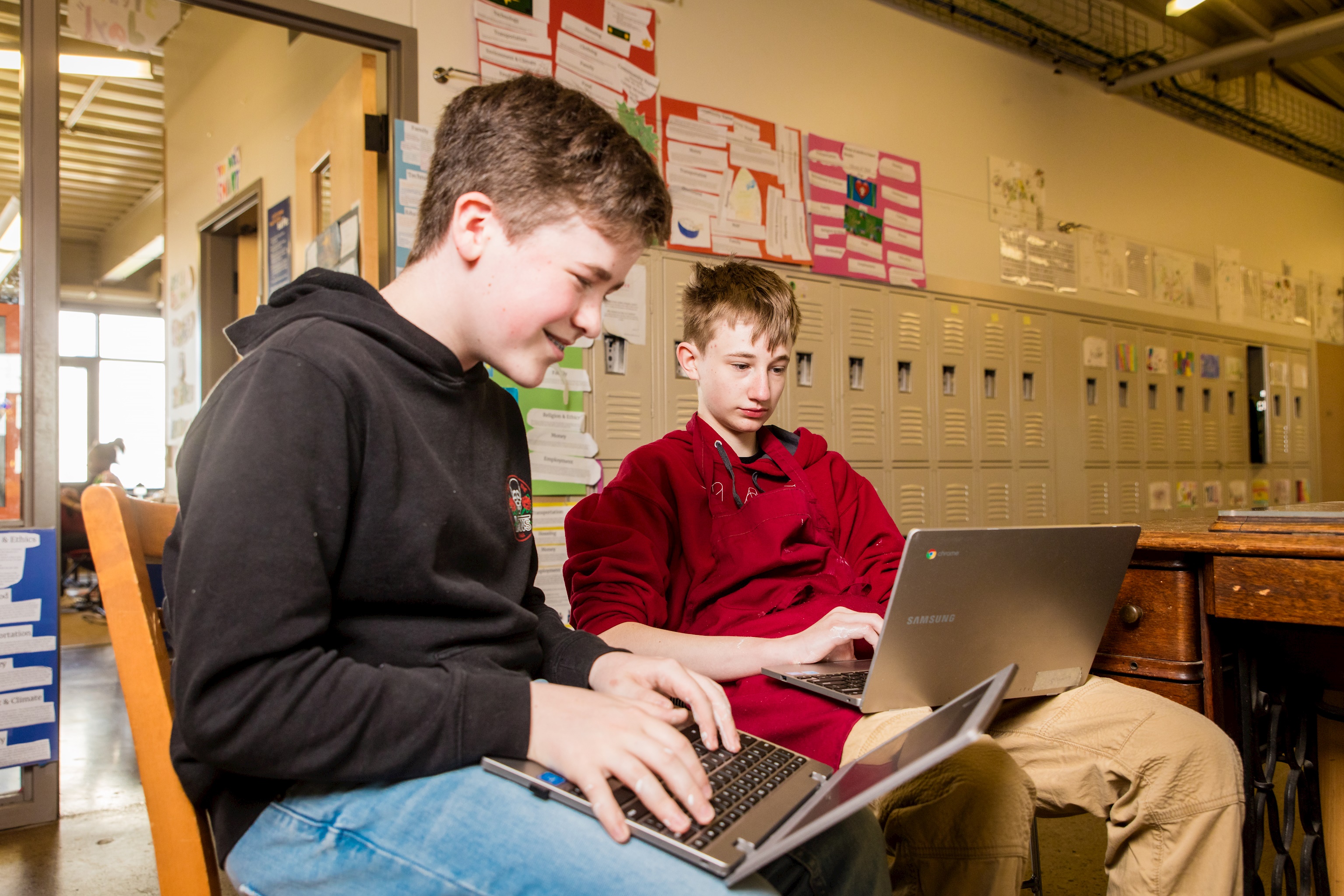Discover our
Home for Learning
- Contact
- 412-624-8020
- [email protected]


What does it mean to be a citizen? What are our responsibilities as members of a community?
These are just a few of the questions that drive Digital Citizenship, a new Humanities class that Falk Lab School students take from grades 1 through 8. While the broad goal of the class is to prepare students to live in a present—and future—permeated by ever-changing technology, Digital Citizenship begins with more fundamental concerns about how to live with others in a community.
“At the Primary level, it’s more about citizenship,” says Lane Ward, who teaches the class. “We look at ideas of community and being a member of a society. Who are the people we interact with in our communities?”
These questions form a foundation on which the class builds in later grades.
Fostering Self-Awareness
At the Intermediate level, Ward says, students are likely to be viewing videos on YouTube or playing video games online, and encountering the kinds of attention-drawing, often-manipulative messages that Digital Citizenship was designed to prepare them for.
“We want them to be more self-aware about the things they’re seeing,” he says.
Ward recalls running a word association exercise with third- and fourth-grade students and asking them to write one word or create a quick doodle in response to phrases like privacy or security. When he gave them the word video, Ward estimates that about three-fourths drew the YouTube logo.
“That’s one example of a sign they are responding to,” he says.
Building toward Coding
Intermediate students also begin exploring the basic idea of an algorithm by breaking down problem-solving processes in the real world. Ward might task students with identifying all the steps involved in something as simple as crossing the room.
“That will lead into basic computer programming like Scratch,” Ward says, “and when they get to Middle School they’ll go deeper into programming.”
The goal is to give students a solid understanding of the fundamental ideas that underlie computer science rather than diving into coding. It’s an approach that is representative of Falk Lab School’s broader educational philosophy, which emphasizes hands-on, student-led learning, and prizes deeper inquiry.
Strands of a Braid

This gradual building toward computer programming also mirrors the approach used by WonderLab, a Humanities course taken by all Falk Lab School students. As Falk’s dedicated makerspace, WonderLab prioritizes physical creation and draws on the disciplines of design, drafting, and fabrication. While the lab is equipped with things like a 3-D printer and Hummingbird robotics kits, the emphasis is on patient, exploratory learning that is hands-on, guided by students’ questions, and that leads gradually to higher-tech experiences such as coding.
Like Digital Citizenship, WonderLab evolved from Falk’s earlier approach to computer-science instruction. These classes, along with Information Literacy, push students to think deeply and critically about the technology they are using and the messages they are receiving.
Digital Citizenship’s focus on thinking critically about the messages we receive complements the work students do in Information Literacy, a Humanities class whose goals include recognizing the rights and responsibilities of living, learning, and working in an interconnected digital world and learning to communicate clearly in a variety of digital media. In Information Literacy, students deconstruct fairy tales, write and record family stories, and explore photography.
Together, these classes might be thought of as strands of a single braid, one that prepares students to navigate a changing media and technology landscape both now and into the future.
“As a society, we have entered the era of ubiquitous computing,” reads a statement of Falk Lab School’s computer science philosophy, “and most children come to us with exposure to and even direct experience with an array of computing technologies. It is our job to help them slow down, step back, wonder, and discover how technologies . . . can help them. Rather than learning to use specific technologies, they are learning to be in the world of technology.”
Culminating Experiences
Middle School students use Carnegie Mellon University’s CS Academy, a Python-based course, to learn coding both individually and in groups.
They also delve more deeply into earlier topics such as how we understand a forum in the internet age and the modes of persuasion used in advertising—Ward has had students focus on political ads used in Pennsylvania’s Senate and Governor races, for example.
“When they get on YouTube, they get all these ads, and they’re asking, ‘Mr. Ward, is this true?’” says Ward. “They have thoughts and questions about these elections all the time. And I want to take a moment to slow things down and have them think, ‘OK, what are we actually seeing and hearing in these ads?’ and have them think more carefully about them.”
One way of fostering that careful thought is by introducing semiotic analysis: unpacking the signs and symbols that these ads and others use to communicate a certain message.
“It’s an aspect of literacy that I don’t think gets focused on enough,” says Ward. “Colors and sounds in advertisements might be communicating to them but they may not always know fully what they’re saying.”
He adds, “It’s all part of building up to being able to participate as citizens in our current technological moment."
